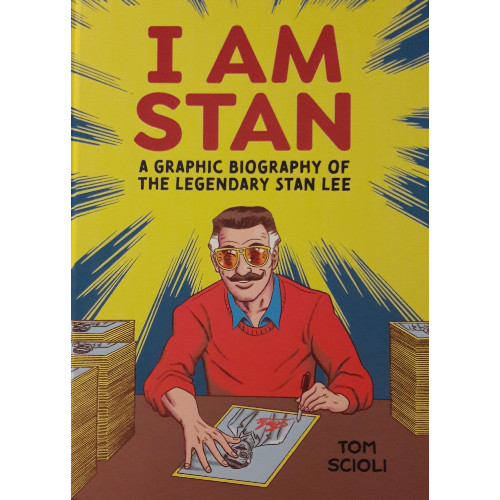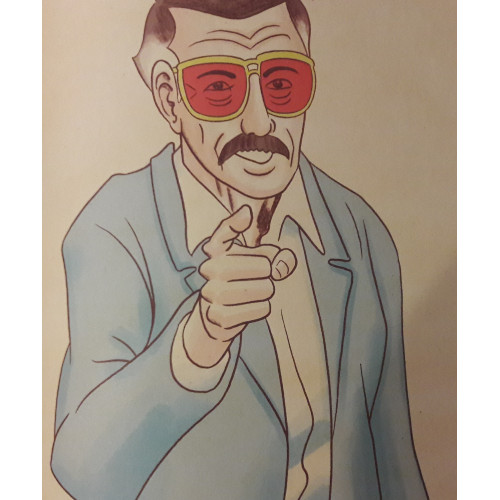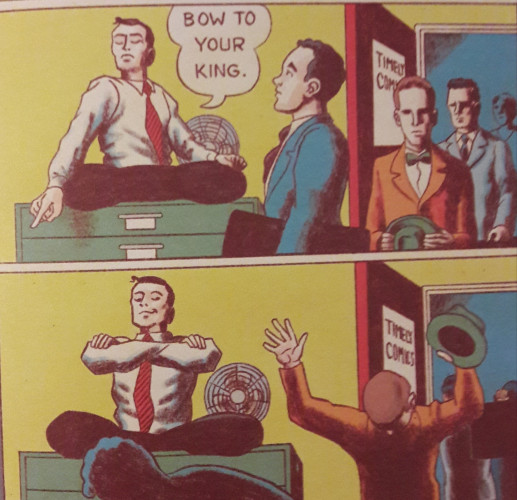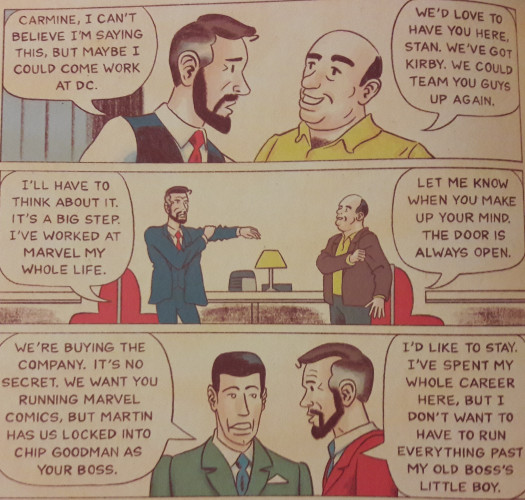Random Reviews: I Am Stan
This illustrated examination of Lee's life is heartfelt and balanced even as it forsakes some depth for brevity
—by Nathan on October 9, 2023—

Back in 2015, Stan Lee, along with Peter David and Colleen Doran, published Amazing, Fantastic, Incredible: A Marvelous Memoir with Gallery Books, an autobiographical account of Lee’s life in response to Marvel Comics’s 75th anniversary. I own the book and have read it at least twice; maybe at some point, I’ll do a review.
What I have here today is similar in form but different in scope and meaning. Nearly five years after Stan Lee’s passing, Eisner Award-nominated writer and artist Tom Sciolo, known for his biographical account of Jack Kirby, has published with Ten Speed Graphic a similar account of Lee’s life. This unofficial biography (as it’s not endorsed by Lee’s family or anyone associated with Marvel) pulls from various interviews, reports, and other sources to give a look at the breadth of Lee’s life, from his childhood in Depression-Era New York to his final days at 95.
With a cry of the magic word "Excelsior!" we can open the pages and see the man Lee was through Sciolo’s artistic vision.
I Am Stan: A Graphic Biography of the Legendary Stan Lee
Writer: Tom Scioli
Penciler: Tom Scioli
Inker: Tom Scioli
Colorist: Tom Scioli
Letterer: Tom Scioli
Volume Publication Date: September 2023
Publisher: Ten Speed Graphic

It may appear strange that I’m posting a review on a text about an important figure (perhaps, for argument’s sake, the most important figure) in Marvel Comics history in this "Random Reviews" category, as opposed to "(Strand)om Stories," where I write about other Marvel publications. As this is a non-fiction work not published by Marvel, "Random Reviews" seems the more apt category. Rest assured, my appreciation for this text falls squarely on Lee's contributions to Marvel history.
Particularly in the last several years, the general public’s perspective of Lee has somewhat shifted and, no doubt, his legacy is being scrutinized perhaps more thoroughly after his death. I don’t fully know the ins and outs surrounding deeper analysis of Lee’s life and choices–specifically regarding just how much credit he genuinely deserves for the creation of some of Marvel’s best-selling characters–but Scioli’s text takes care in maneuvering the minefield. He doesn’t treat Lee delicately or place him on a pedestal, but he doesn’t have time to deeply address some of those issues. This is, as the subtitle declares, "A Graphic Biography Of The Legendary Stan Lee," not "A Graphic Argument For How Legendary Stan Lee Actually Was."

I was largely curious, remembering what I did of Amazing, Fantastic, Incredible, how Scioli’s version would differ from Lee, David, and Doran’s text–would Scioli just tack on three extra years of Lee’s life and call it a day? "No," was the definitive reply, and though there is significant overlap between events discussed, Scioli’s approach is much more streamlined. AFI uses Lee as its central narrator, dictating the events of his life as a first-person storyteller relaying key points and memories to his audience. Scioli opts for a much more empirical approach–he seems mainly interested in the facts, in distilling Lee’s life down to important scenes and locations with absolutely no commentary or reflection on events as they occur. There’s no "talking head" Stan Lee who can forewarn the consequences of certain actions or guide the reader through the years. Everything is very straightforward.
This method aids Scioli in his depiction of Lee. Without an outside narrator leading us, we behold the story as it unfolds and are invited, wordlessly, to make our own inferences about Lee's character and personality based on the scenes presented. Indications that Lee developed some sort of arrogant attitude are depicted through actions taken, such as a younger Lee painting "Stan Lee is God" or a slightly older Lee, as a newly appointed editor of then-Timely Comics, scrambling to the top of a filing cabinet and telling his subordinates to "[b]ow to [their] king." This latter scene is nicely juxtaposed with a sequence of Lee at a party, shyly informing some folks he works in comic books. Visually and textually, we’re offered these two sides of Lee, simultaneously commanding in comfortable environments yet more timid in situations unfamiliar or outside his control. And that’s my personal inference based on the details provided; another reader could interpret the scenes differently, and the beauty of Scioli leaving his own commentary at the door is we’re allowed the freedom to analyze these scenes as we wish given context clues.

Yet very little guidance, though allowing for more dynamic reading, hinders how we progress through events. Each moment is given fairly little focus–we move from scene to scene without captions, often without setting or time established. At times, we’re suddenly thrust into flashbacks we must correlate with present periods, and juggling these disparate threads, though an intriguing exercise conceptually, bungles the narrative’s flow. A moment where Lee succeeds in one venture is undermined by the next panel informing us of its failure, which is then devalued by another event. Lee briefly flirts with the idea of leaving Marvel for DC, a train of thought quickly addressed and then wrapped up in a handful of panels, leaving me curious about the bigger picture. Wait, what just happened? I wondered. I want to learn more! How did that develop? What were the ramifications? We cannot fully process important events when we’re suddenly drawn into a new setting, a new event, with new faces and names. We're not allowed to sit in the moment. Given Scioli is covering nearly 95 years of history, one shouldn't expect I Am Stan to be definitive. Still, the format means the story interrupts itself when it could take more time, even in a few places, to better orient the reader.
I could often comprehend the chronology of events–it’s easy to understand, for example, that Lee’s initial employment at Timely is interrupted by World War II, followed by him resuming his responsibilities, followed by the comics scare caused by Fredric Wertham’s Seduction of the Innocent, followed by the eventual resurrection of superhero comics. What’s harder is placing these events in their larger context–how much time passed between Lee resuming his Timely position and the comics scare? In what exact years did these events occur? Outside research could answer those questions, sure, but I would’ve preferred some information within the story to frame the context, even if it was only some additional dates.

Personal analysis becomes more important the deeper you get into the narrative as Lee’s life becomes increasingly complex. We witness disagreements with colleagues (and former colleagues), discussions surrounding the proper distribution of credit for creating certain characters or stories, and plans which don’t pan out. Lee is presented as creative and ambitious, jumping at every opportunity and taking full advantage of his skills and charisma, sometimes to the detriment of those around him. But Scioli makes it clear that, even if Lee puffed himself up and twisted details to suit his needs, the man wasn’t a fraud. There’s a very real sense that Lee was genuinely ambitious and skillful in seeing those dreams made tangible and that any manipulativeness or demeaning behavior was an extension of misplaced ambition. Scioli doesn’t excuse his foibles, but he shows from where lapses in judgement sprouted.
Quick as the narrative trips along, comic book fans will certainly get a kick at this glimpse into Lee’s development, as well as the people he interacted with and the world he inhabited. It’s just pure fun to witness Lee’s first interactions with Jack Kirby, Steve Ditko, and Roy Thomas or even a somewhat sarcastic interaction with Rob Liefeld and Todd McFarlane. You’re allowed to geek out, momentarily, over the creation of Spider-Man, the Hulk, the X-Men, Iron Man, and the Avengers. Scioli adapts his style to wonderfully reproduce panels and covers from original issues to reflect their artists, whether it’s Jack Kirby’s Avengers, Fantastic Four, or X-Men or Steve Ditko’s Spider-Man or Doctor Strange. As we near Lee’s later years, we’re treated to a series of panels depicting his cameos in various Marvel movies, from the first Spider-Man, X-Men, and Fantastic Four films (as a quick aside, Lee's brief role as Willie Lumpkin is still my favorite cameo of his), to MCU entries such as Iron Man, Thor, and Avengers: Age of Ultron. Moments like these are given greater care and reflection, perhaps as they connect better with a broader audience than analyzing the minutiae of Lee as a comic book writer and editor.

"Lee as writer" and "Lee as pop culture icon" are thus both presented, with the latter growing out of the former and allowed more heft as the graphic novel closes out. The full range of Lee’s contributions to fandom–from his early writings, to his editing contributions, to his speaking engagements, to his involvement in other entertainment venues–are all covered, not always in breadth, but you do walk away with a general understanding of all Lee achieved. Again, Scioli isn’t looking to canonize Lee, but there’s little arguing Lee’s significance in the industry, even if it came at the cost of overshadowing folks deserving of more significant recognition.
The graphic novel ends with a bittersweet overview of Lee’s final days, marred by situations not fully in his control. Like the rest of the narrative, we’re offered an overview of the situation, and I’d encourage anyone interested or invested in Lee, his life, and his creations to dig deeper. We’re given only part of a conversation between Lee, Liefeld, and McFarlane available in its entirety online. A longer biography, True Believer: The Rise and Fall of Stan Lee, is considered definitive. Amazing, Fantastic, Incredible and Stan Lee’s Amazing Marvel Universe offer looks at Lee’s career and creations through his own words. Though not completely comprehensive, Scioli’s narrative provides a well-researched, respectful, and balanced overview of Stan Lee’s life which recognizes the pitfalls of his personality while also acknowledging his many accomplishments.
"Excelsior!" indeed.